|
 |

|
 |
Promotions
All enlisted personnel in the German Military start out as a "Soldat" or their branch equivalent. For instance a soldier in a Hussar regiment would be referred to as a "Husar" or "Ulan". While other other Armies had distinctions between privates, in the German Army all privates were basically the same, thus the German rank structure, while comparable to other Armies is not an exact fit. For instance, the Rank of Gefreiter is roughly equivalent to a Lance Corporal or Private First Class in the US Army, yet the responsibilities assigned to the Gefrieter are more in line with a Junior NCO (Corporal).
Furthermore German Soldiers progressed through the ranks at a very slow pace. Typically a Soldat would not be eligible for promotion to Obergefreiter until he had been in the Army for six years.
Voss joins the Westphalian Hussars on !6 November 1914 assumes the rank of Husar (troop) or Ulan (lancer). His rank equivalent in other armies would be that of a recruit or Private.
Gefreiter: Acting Corporal (sometime referred to Lance Corporal).
Effective: 27 January 1915
Gefreiter is the lowest rank given to an Non-Commissioned Officer in the Imperial German Army. While the title "acting" sounds temporary, it is not. It refers to soldier that does not have the time in grade and has not attended a NCO training course but has proven that he is capable of being a corporal by his actions. Upon completing the necessary training he would be promoted to Obergefreiter (Corporal). For all intents and purposes, the responsibility of the position similar to corporals or lowest ranking NCOs in other armies
Unteroffizier: Acting Sergeant.
Effective:18 May 1915
The main difference between the Unteroffizier and the Sergeant is time in grade and lack of official schooling. Voss had gone from Hussar or Private to Unteroffizier in less than seven months.
Vizefeldwebel: Staff Sergeant.
Effective: 2 March 1915
The Vizefeldwebel and above wore an officer's sword knot and a peak on the field cap. Voss had completing training an instructor with FEA7 and this training is probably what elevated him to the rank of Vizefeldwebel or Staff Sergeant.
Leutnant:
Effective: 9 September 1916
Leutnant, the lowest Commissioned Officer rank. Most pilots in the German Army were given a Reserved Commission. It gave them all the authority and responsibility of a career or regular army officer but without the guarantee of still holding the commission after the war was over. Thus Voss's commission differed from that of von Richthofen's in that Richthofen had gone through a military school and had obtained a regular army commission (For more information on German Rank, see Rank Insignia of the German Army, 1914-18
|
The German did not award the same medal more than once. After all the award was for continual action and not individual acts. Thus, if the soldier continued to prove himself he would usually receive an award higher importance rather than the same award again. Also a soldier would not receive a medal of lesser value if he had already earned a higher award. |
|
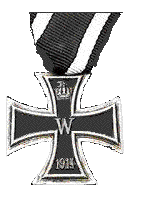
|
Eiserne Kreuz 2 - EK2 (Iron Cross, 2nd Class) Awarded on or about: 27 January 1915 Werner Voss received the EK2 upon being promoted to Gefreiter. The promotion and the award were most likely given because of his continual display of bravery, his leadership skill, or both. The Eiserne Kreuz (EK) or Iron Cross was awarded to individuals other than senior commanders for superior merit in combat. It was specifically designed as a war time award. The combat version of the EK2 had a black ribbon with two white edge stripes, the non-combat version had a white ribbon with two black edge stripes. Typically only the ribbon was worn with the uniform. It was passed through a buttonhole on the tunic. |
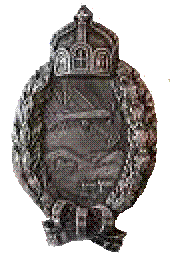
|
Pilot's Badge (Prussian) Awarded on or about 28 May 1916 Despite the common belief, the Pilot's Badge was not awarded upon completion of pilot training. A pilot would receive the Pilot's Badge after gaining experience in aerial combat. Voss completed pilot training and was immediately assigned as an flight instructor. He remained a flight instructor for six months and therefore was incapable of receiving his Pilots Badge. Voss was assigned to a combat unit in February. Even though Voss was an accomplished pilot he flew as an observer for some time. This was not uncommon in such units. New pilots would fly as observers in order to become acclimated to aerial combat. Once they became confident and trusted in the air they would then assume the duties as the pilot. This explains why Voss went to flight school in August 1915 but would not receive his Pilot's Badge until nine months later. |
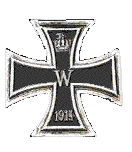
|
Eiserne Kreuz 1 - EK1 (Iron Cross, 1st Class) Awarded on or about: 2 December, 1916 Voss received the EKI for his first two aerial victories which occurred on 27 November, 1916. Most Jasta pilots received the EK2 upon confirmation of the first aerial victory and would typically get the EKI around their fifth aerial victory. However, it was common practice to give the EK1 for a first aerial victory if the pilot had already earned the EK2, rather than have him wait until he achieved five victories. It probably had more to do with building confidence than anything else. The EK1, was identical in every way to the EK2 except that it did not have the neck ribbon. Instead it was affixed to the uniform with a pin clasp . It was was worn on the left breast pocket. |
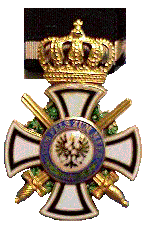
|
The Cross of the Order of the House of Hohenzollern Awarded on or about: 27 March 1917 The House of Hohenzollern was a Prussian order bestowed on officers for bravery in combat. It normally was awarded if the recipient had already received the EK1. Among Jasta pilots, it was typically awarded somewhere between their twelfth and fifteenth victory but this was not always the case. Voss was credited with his fifteenth victory on 11 March 1917 and managed to increase his score by seven additional victories in less than two weeks. He had actually passed the mark for the Pour LeMérite within one week of when he should have received the Hohenzollern! Because of his quickness in the air, Voss received the Hohenzollern after achieving 22 aerial victories. While some authors have used this as proof that there was a conspiracy against the working class Voss, it most likely was due to the fact that he could shoot planes down faster than German Staff Officers could process paperwork! To the credit of Voss's superiors they insured that he received the Order of the House of Hohenzollern before receiving the Pour LeMérite. |
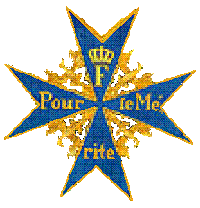
|
Pour LeMérite (The Blue Max) Awarded on or about: 8 April 1917 The Pour LeMérite was awarded for repeated and continual acts of gallantry in action. It was required to be worn while in uniform. It was never awarded posthumously. By 1917, the Pour LeMérite was typically awarded to combat pilots after confirmation of their 20th victory. Typically, along with the award, the pilot would receive a month's leave. Voss received his Pour LeMérite after his twenty-fourth victory, just one week and two victories after receiving his Order of the House of Hohenzollern. Again this probably had more to do with how slow paperwork moved rather than some kind of class conspiracy within the German Army. |